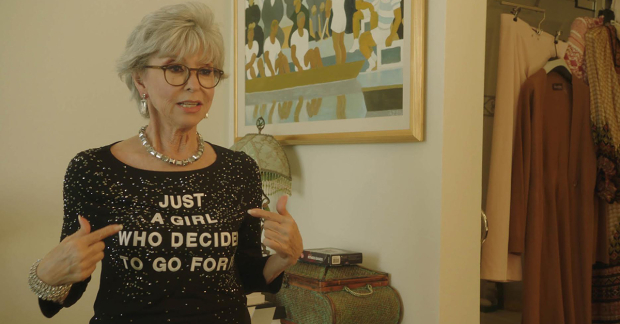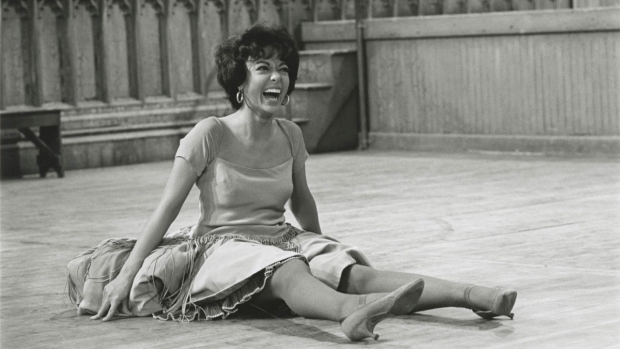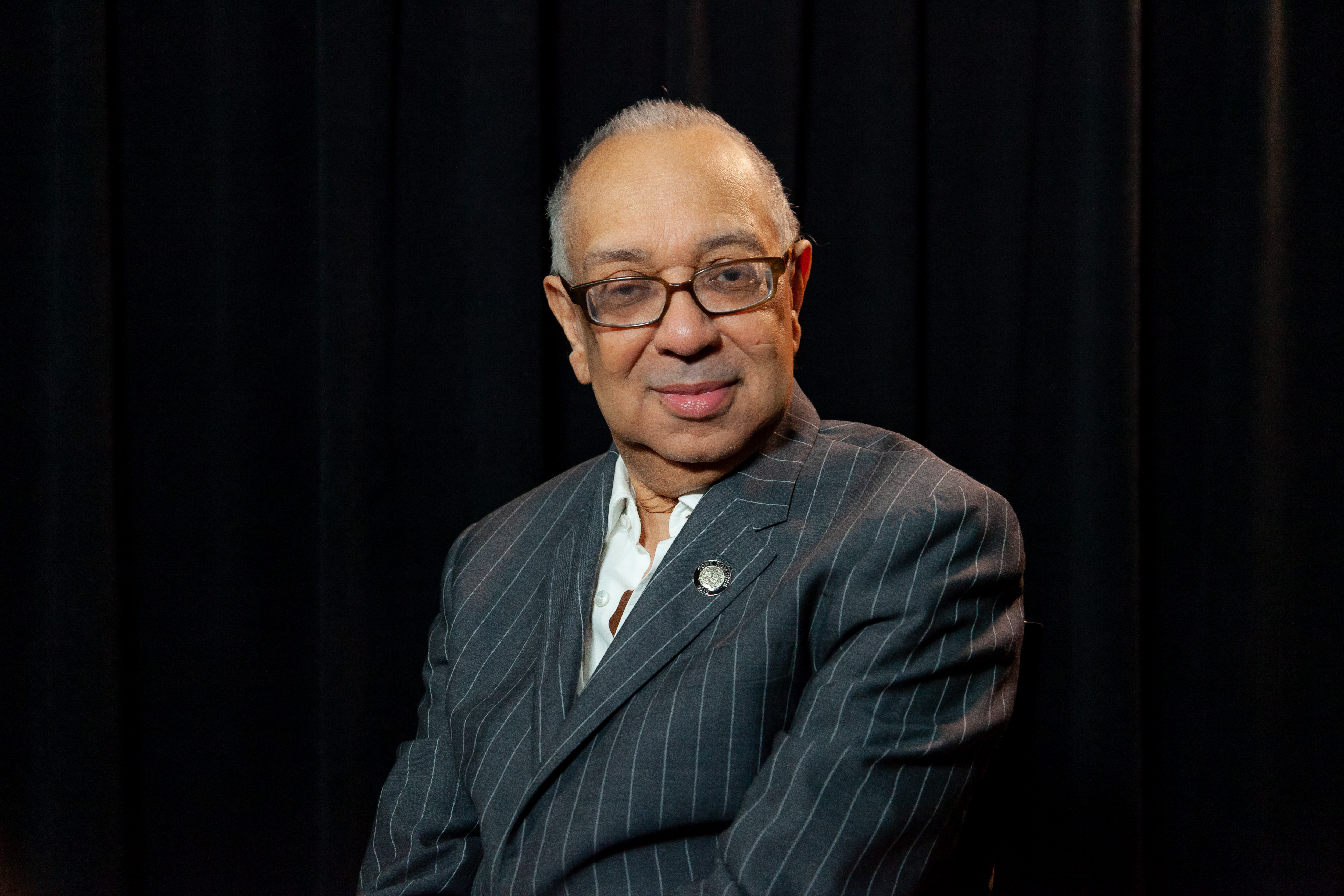Review: A Star Is Reborn in Rita Moreno: Just a Girl Who Decided to Go for It

(image courtesy of Sundance Institute)
Rita Moreno: Just a Girl Who Decided to Go for It aims to be as much a crowd-pleaser and truth teller as its vivacious, delightful subject is. The tidy hour-and-a-half documentary from Puerto Rican director Mariem Pérez Riera seeks to contextualize Moreno's current cultural reemergence with her historic impact on the face of entertainment, and brings along a gaggle of huge names to do so.
As an installment of PBS's American Masters series, this format is expected, easily digestible, and provides for some nostalgic archival delight, but for an outsize personality like EGOT-winner Moreno (enthusiastically declaring "I'm as big as you get!"), being crowded by other celebrity faces and their assumptions can sometimes be more distracting than elevating.
The film wastes no time introducing Moreno's straight-shooting, affable charm, inviting the audience to attend her 87th birthday party (the film was shot in 2018). While those familiar with Moreno's work know a legend when they see one, Moreno attempts to dispel that awe early on — much as the title of the film might suggest.
"Yes, it goes up and down. Right now it's up," Moreno says of her current popularity, largely due to her fan-favorite role on the just-canceled reboot of One Day at a Time. As the chronology of the documentary demonstrates, the lifelong entertainer knows that one day you can win an Academy Award for the most iconic Latinx role to grace the American musical canon, and for the next seven years no film work comes your way.

(image courtesy of Sundance Institute)
In this first chronological half, Pérez Riera effectively uses Moreno's singular personality to paint a wide landscape of the pervasive cultural maladies plaguing 20th-century Hollywood, such as fashioning herself into a "Spanish" Elizabeth Taylor lookalike for her fateful meeting with MGM head Louis B. Mayer, and spends her contracted years in the studio system playing every "ethnic" damsel in distress with the same accent — with no white executive the wiser.
It's startling to watch such scenes of Moreno bamboozling her way through Hollywood, her skin tone changing according to the whims of a white person's imagination. Her commentary is revealing — even her most iconic turn as Anita in West Side Story is fraught, as she portrays a beloved white writer's colonialist American ideas about the inferiority of Puerto Rico — a view Moreno firmly disavows.
Though Moreno survived this and many other nonchalant brutalities, the documentary also indicts a culture of death by a thousand cuts. With the briefest of supporting interviews from fellow studio starlet Mitzi Gaynor, Moreno describes the casualness with which she and other actresses were meant to be treated as sex objects. She speaks of her agent raping her, and the tragedy of keeping him on even after, because at the time she saw him as one of the only people in Hollywood who looked out for her.
These accounts are aptly connected to Moreno's present, outspoken stance as an advocate for survivors of sexual assault, and reproductive rights. As Moreno dresses for a taping of One Day at a Time, she watches the testimony of Dr. Christine Blasey Ford — particularly the moments where Republican congresspeople attempt to discredit her — and it's clear Moreno sees the impact of generations worth of white supremacist, patriarchal violence. "Oh, bullshit!" she yells to the senator attempting to winnow holes in Blasey Ford's testimony — a cathartic sentiment especially when wielded with such award-winning authority.
This is when the film is at its best: when Moreno shines with the incisive candor and wit of a star more attuned to her own truth than she's ever been. Many interviewed performers, including Eva Longoria, Gloria Estefan, and Justina Machado rightfully adore the first Latinx actor for laying the groundwork for their own careers. However, other interviewees, including perpetual documentary fixture Whoopi Goldberg, executive producer Lin Manuel Miranda, and her Electric Company co-star Morgan Freeman, don't illuminate much when it comes to Moreno herself, and their contributions are mostly forgettable.
The documentary's conclusion hits a wall in its competing legitimacy of subject and expert. Many of the worshipful interviewees have spent time expressing how difficult Moreno's life must have been, to the point of somewhat downplaying Moreno's resilience and ability to move through her trauma. One expert in particular, historian Frances Negrón Mutaner, focuses on how Moreno might have been able to excel, if not for the racist and sexist institutions in her way.

(image courtesy of Sundance Institute)
This viewpoint, while entirely worthy of dispelling the mythos of the bootstraps American dream, is at odds with Moreno's view of her current healing and happiness. When asked if she thinks these various hardships took a slice out of her, Moreno answers in the negative. Even as she alleges that she's happier than she's ever been, after the years of therapy and introspection she deems necessary to be a "whole person," the documentary concludes with Mutaner's commentary, and the Nina Simone song "I Wish I Knew (How It Would Feel to Be Free)."
This undercutting is puzzling, given the honesty with which Moreno opens old stories of harassment, abuse, abortion, marriage, and loss. The inclusions of Moreno's frustration over having said so little in her Academy Award acceptance emphasize the most enjoyable parts of the documentary: Moreno celebrating, dancing, and speaking for herself. Editorializing the film's ending in this particular light obscures the words of its biggest draw.
Overall, Rita Moreno: Just a Girl Who Decided to Go for It balances nostalgia and shattering truth for older musical aficionados, and is a complex, layered history lesson for younger fans — and it is especially magnetic when Moreno is allowed the space to tell her story her way.










